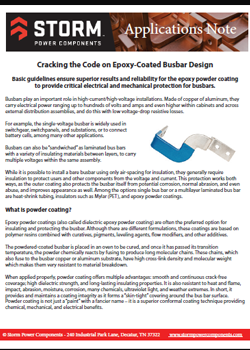Cracking the Code on Epoxy-Coated Bus-Bar Design
June 19, 2023 5:30 pm
Basic guidelines ensure superior results and reliability for the epoxy powder coating used to provide critical electrical and mechanical protection for bus bars.
Bus bars play an important role in high-current/high-voltage installations. Made of copper or aluminum, they carry electrical power ranging up to hundreds of volts and amps and even higher within cabinets and across external distribution assemblies, and do this with low voltage-drop resistive losses. For example, the single-voltage bus bar is widely used in switchgear, switchpanels, and substations, or to connect battery cells, among their many applications. Bus bar can also be “sandwiched” as laminated bus bars with a variety of insulating materials between layers, to carry multiple voltages within the same assembly.
While it is possible to install a bare busbar using only air-spacing for insulation, they generally require insulation to protect users and other components from the voltage and current. This protection works both ways, as the outer coating also protects the bus bar itself from potential corrosion, normal abrasion, and even abuse, and improves the appearance as well. Among the options single bus bar or a multilayer laminated bus bar are heat-shrink tubing, insulators such as Mylar (PET), and epoxy powder coatings.
What is powder coating?
Epoxy powder coatings (also called dielectric epoxy powder coating) are often the preferred option for insulating and protecting the bus bar. Although there are different formulations, these coatings are based on polymer resins combined with curatives, pigments, leveling agents, flow modifiers, and other additives. The powdered-coated bus bar is placed in an oven to be cured, and once it has passed its transition temperature, the powder chemically reacts by fusing to produce long molecular chains. These chains, which also fuse to the bus bar copper or aluminum substrate, have high cross-link density and molecular weight which makes them very resistant to material breakdown.
When applied properly, powder coating offers multiple advantages: smooth and continuous crack-free coverage; high dielectric strength, and long-lasting insulating properties. It is also resistant to heat and flame, impact, abrasion, moisture, corrosion, many chemicals, ultraviolet light, and weather extremes. In short, it provides and maintains a coating integrity as it forms a “skin-tight” covering around the bus bar surface. Powder coating is not just a “paint” with a fancier name – it is a superior conformal coating technique providing chemical, mechanical, and electrical benefits.
Why use powder coating?
Powder coating is especially well-suited to the needs of busbars. As a coating, it uniformly covers the surface, even for bus bars with tight geometries and complex shapes often needed for tight spaces or complex systems. Further, the coating add minimal weight and bulk, with a typical thickness ranging from 6 to 120 mils (0.006 to 0.120 inches). Since the epoxy powder is applied after all bending, contouring, punching, and milling of the bus bar, it offers a consistent application across and along the entire surface.
Electrically, powder coating also has attractive specifications. It offers a typical insulation rating of 800 volts per mil while the dielectric strength depends on application process, coating thickness, and bus bar preparation. The useful insulation life of the powder coating is impressive in in comparison with other common insulating materials. Further, as a bonded conformal coating, it reduces the risk of flash-overs and partial discharges as there is no air gap between conductor surface and insulation.
Temperature ratings for powder coatings are also high, with a typical value of 130°C as characterized by relevant UL standards (94 V-0 Flammability standard), depending on the specific formulation of the coating material and application factors.
Powder coating can be applied in one of two ways: by electrostatic spray of the powder or by immersion in a fluidized bed of powder, with both followed by oven curing. The decision of which application technique to use is based on bus bar’s size and shape as well as electrical requirements. Bus bars with fairly flat geometry are better suited for spraying, while bus bars with many turns and tight bends are a better fit for fluidized bed powder coating.

Electrically, the spray approach works well at lower voltages, up to 600-100 V with a coating which is 10-20 mil thick. Immersion in fluidized bed is a better choice for higher voltages such as 5 kilovolts (kV) and even up to 35 kV where coating thicknesses of 50-120 mils are needed.
It is also important to take steps to avoid cracking and to conduct rigorous testing to assure electrical integrity
Conclusion
Use of powder coating on basic bus bars and laminated busbars is the preferred technique to address issues of electrical insulation, physical protection, and bus bar integrity. By following guidelines provided by a knowledgeable vendor, and by leveraging the vendor’s know-how and production expertise, issues such as coating cracking can be avoided. The result will be a reliable, long-life bus bar installation which meets all performance objectives.
Details are available in this Applications Note on Epoxy-Coated Busbar Designs and Best Practices

Additional References at Storm Power Components
• “Epoxy Edge Preparation” (video)
• “Insulated Copper Bus Bars”
• “Dielectric Epoxy Powder Coating”
• “Multi-Layer Laminated Bus Bar”
• “Laminated bus bar - Multiconductor”
• “Dielectric Finishing - a.k.a. Epoxy Powder Coated Insulation”
• “Design Guide: Epoxy Powder-Coated Busbar Insulation”
Bus Bars | by Storm Power Team
Comments are closed here.